Back to The Future: The Function of Supporting Characters
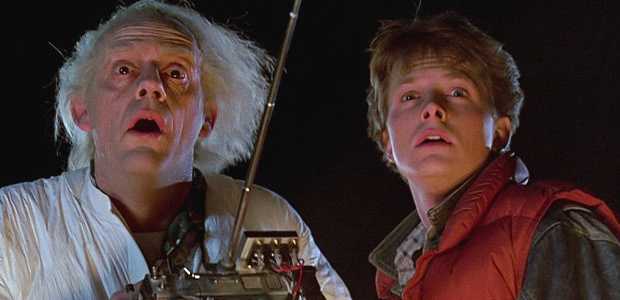
Supporting characters play a significant role in the deployment of a film’s narrative and highlight key elements that help unmask aspects of plot, personalities, motivations and back stories that might otherwise have remained hidden. In the 1985 film Back to the Future, Marty (Michael J. Fox) is confronted by a palette of characters who impact his journey as much as he changes their lives, in both 1955 and 1985. Doc Brown (Christopher Lloyd) and Biff (Thomas F. Wilson) are particularly important, as they are defining figures in Marty’s journey – although they are physically and morally opposed, they both correspond to a conventional cinematic type forged by Hollywood style. The audience can easily recognize them, thus helping establish the bond between the spectator and the Hollywood model. They also contribute to the establishment of the film’s genre and tone. Finally, they represent different kinds of masculinity and divergent sets of values that Marty can choose to embrace or defy, which helps the audience identify with him and contributes to the protagonist’s growing up.
Supporting Characters as Character Types
The supporting characters in Back to the Future contribute to the construction of a secure relationship between the spectator and the classical Hollywood model as defined by Bordwell and Thompson 1, a model which values the importance of straightforward narratives and easy plots where we can follow the adventures of one character and identify with his emotions. In many aspects, Robert Zemeckis’s film adopts this classical aesthetic with a goal-oriented protagonist as a focused point of identification which streamlines the narrative action. A series of cause and effect events occur over the course of the narrative which complicate Marty’s journey, and the agents of these events are the supporting characters. They are constructed stereotypically for the audience to classify them as helpers or obstacles to the protagonist. Doc and Biff both correspond to two character types that nearly always feature in Hollywood films: the helper and the villain. Doc is the wizard of the story, the older and supposedly wiser man who puts Marty on the path to adventure and becomes the ideal partner, full of resources and always able to find solutions to what seemed a desperate situation. As Zemeckis said, ‘the story is anchored in a sort of benevolent Merlin/Arthur kind of relationship between Dr. Brown and Marty‘. By comparing Doc to the legendary figure connected to King Arthur’s life, the director places him in the sphere of marginal characters and the audience associates him with wizardry, unusualness but also with sympathy, humanity and protection, qualities that are classically associated with the ‘friend’ character who supports the Hollywood protagonist.
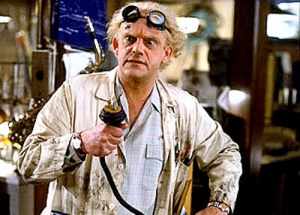
Doc is presented from the start as a great mind and matches all the typical images we associate with scientists. His environment is introduced in the opening sequence but his name and appearance is not revealed to the viewer in this part. As the camera slowly pans around the lab, we identify curious objects that tell us that the person who built this strange mechanism is both an outcast and a genius: gadgets are programmed to prepare breakfast, give the dog his food, turn on the TV, and many clocks tick at the same time which foreshadows his obsession with time. The newspaper article about the Brown mansion being destroyed is a clue to the rest of the plot and introduces the name Brown to the audience for the first time. The camera then lands on several photos of famous scientists like Albert Einstein and Benjamin Franklin which immediately sets Doc as a science enthusiast to the subconscious of the viewer. When Marty comes in and shouts for ‘Doc’, we understand that he is searching for the owner of the lab. The name of ‘Doc’ instantly alludes to a certain status, that being an academic level reached after many years, a label that matches the objects found in his house and helps portray Doc as a scientist. All these clues are left for the spectator to construct his own image of Doc before meeting him. The film plays with the usual symbols we associate with scientist figures in order for the character to be understood alongside his stereotype. The introduction to Doc is therefore embedded into caricatured images that have been established through Hollywood tradition and helps construct a connection between audience and film.
In contrast, Biff is the prototype of the villain. As Alfred Hitchcock said, ‘the better the villain, the better the film’ – Hollywood narrative needs to construct a generic and easily recognizable character to personify evil, and therefore, give the protagonist an antithetic counterpart. Biff always appears in the crucial moments when Lorraine (Leah Thompson) and George (Crispin Glover) are about to connect, thanks to Marty’s efforts and always ruining his plans. By making his mission even tougher, Biff represents an obstacle that Marty has to overcome which creates tension and excitement for the audience and thus serves to fulfill what is, arguably, the purpose of Hollywood film: to entertain. The antagonism between Biff and Marty/Doc is even portrayed through the positioning of actors within the frame – although Doc and Biff are both very tall compared to Marty, Doc never towers Marty and they are often positioned on different planes of depth to avoid height differences (which is representative of their equal relationship), whereas Biff always looks imposing opposed to Marty, ready to overpower him. Therefore Biff is constructed as the abusive enemy that has to be contained by the hero and his helper. This remains as close as possible to classic stereotypes of storytelling, so that the audience can easily understand where Marty stands in relation to the supporting characters of the story.
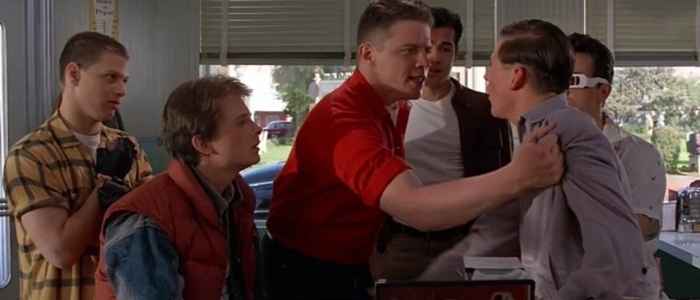
Biff is constructed conventionally with little complexity or nuance – he is like a marionette, a dumb character only interested in establishing his physical power over others to get what he wants. He imposes himself upon George through constant bullying and upon Lorraine through sexual abuse. Biff is often accompanied by a gang, his followers, which establishes an even more stereotypical image of the teen villain as a source of danger and power. The gang ventilates and accentuates rage and machismo whenever Biff is being contradicted or just wants to have fun bullying students. They often appear in a car driven by Biff which suggests he is in control and leads the way. For Steve Bailey and James Hay 2 the car is a physical site in ‘which the social identities of youth find articulation’ , a means of mobility and escape from the confines of authority which suggests that Biff places himself above rules and establishes his own authority.
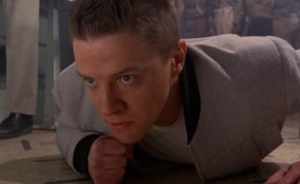
The scene in the 1955 diner when George is about to ask Lorraine out acts as the first confrontation between Marty and Biff, between hero and villain. Lucy Fife Donaldson 3 analyses the scene with a particular focus on Biff’s physicality – tall and muscular – she states that he is much more plain and overtly masculine than the McFly men, which is illustrated through Biff’s entrance into the diner. He enters with his gang and verbally assaults George (‘I told you never to come here’), asking him for money and pushing a kid out of his way like a proper bully. His physical presence is as imposing as his mental oppression, which securely supports his role as the villain. When Biff trips over Marty’s foot, his anger is expressed by grimacing and clenching his fists, which is very cartoonish. Fury and violence is performed in a stereotypically ‘ubuesque’ way which leads the audience to automatically associate Biff with the villain type. The film then cuts to Biff jumping back on his feet, the camera positioned behind him in a low angle while he menacingly stares at Marty. As he reaches the full extent of his height, Marty is dwarfed and eclipsed from our view which emphasises Biff’s towering physique compared to Marty. Biff’s fall and recovery foregrounds his bulk and the violence he is ready to unleash on whoever defies him. However, Marty manages to knock Biff over, which comes as a surprise to Biff’s self-construction but satisfies the expectation of seeing the hero triumph over the villain in Hollywood films. The diner scene therefore sets up clear conventions, especially around the caricatured portrayal of Biff, which are recognized by the audience and provides pleasure and entertainment, solidifying Biff as the perfect representation of the Hollywood villain type.
Supporting Characters As Indicators of Tone
In Back to the Future, the supporting characters also participate in the construction of the film’s tone and are each connected to a specific genre displayed through a varied set of images and allusions. Doc provides the comedy material of the film through his exaggerated facial expressions, his slapstick/farcical play-like actions and his enthusiasm which often contrasts with Marty’s incredulity. This is exemplified in the scene where Marty cannot believe Doc has built a time-machine out of a DeLorean and Doc answers: ‘the way I see it, if you’re gonna build a time-machine into a car, why not do it with some style?’. Marty’s bewilderment is swept away by Doc’s enthusiasm, at odds with Marty’s seriousness which creates a funny dynamic between them. Doc has some of the funniest lines in the film like when he is about to show Marty how the DeLorean works and says: ‘Now, if my calculations are correct, when this baby hits 88 miles an hour, you’re going to see some serious shit’. The switch from scientific formalism to colloquial language creates a hilarious contrast and promotes Doc to a figure of comic relief which adds a lighter tone to the film.
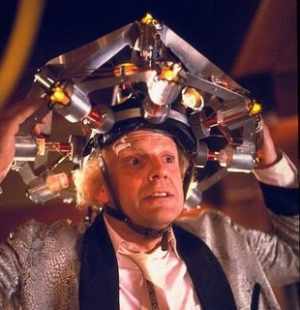
On the other hand, Doc also connects the film to the horror and gothic genre through his characterisation as the crazy scientist. For Andrew Shail and Robin Stoate, the two Doc Browns in the film represent ‘two major sci-fi permutations of the scientist: the absent-minded benign boffin and the crazed lunatic’. This shows that by adopting the typical imagery used to represent laboratories scientists in cinematic history, Doc participates in establishing the film into the sci-fi genre. This is illustrated in the parking lot scene when we first meet Doc as he is about to introduce Marty to time-travelling. 1980s Doc looks like a typical scientist – messy white hair, crazy eyes and passionate facial expressions, wearing a white radiation suit… He comes out of the truck like an alien coming out of a spaceship. The music is heightened and the sound of chimes bring something magical and enchanting to the scene which sets Doc above normality, as we expect him to be as a scientist. 1950s Doc is not that much different, although he is even more remote from the world, confined within his garage and unwilling to open doors to strangers. When Marty finds Doc in 1955, the scene is framed from below so the ceiling fills much of the background which is a typical composition used to suggest derangement and disorientation, feelings linked to the horror/gothic genre and the image of the ‘nutcase’ scientist. When Marty tells Doc that in the future, he makes time-travel possible, Doc falls on his knees and shouts ‘It works!’ which echoes Colin Clive’s ‘It’s alive’ in Frankenstein (1931, Whale) and clearly alludes to a history of horror films. Thus, Doc brings elements of comedy and science-fiction to Back to the Future and makes it easier for the audience to recognize the film’s different genres.
Like Doc, Biff participates in the construction of the film’s multiple genres and tones but brings a totally different colour to it by providing tension and drama. This is particularly visible in the scene in the parking lot at the School’s Dance when George is about to save Lorraine from Marty, but realises that the person in the car is Biff. The audience is immediately aware of the danger. What looked like teens ‘fooling around’ transforms into actual rape. When George interferes, Biff threatens hims. He holds George in an inescapable arm lock, the camera slowly panning to the ground to follow George’s suffering face and showing Biff triumphant in a higher angle. The tense music, an eight-note phrase played repeatedly on two octaves of a piano and a rapid scraping of strings, brings intensity to the scene. This kind of music is usually reserved to horror films or climatic moments in action narratives – Biff marks a change of tone in the film as it becomes more anxious, adding a layer of danger and drama to the plot. Therefore, through his conventional performance of the villain, Biff represents the darker tones of the film and addresses more serious issues like teen violence and rape, issues that are at the heart of Marty’s journey. By personifying these themes, Doc and Biff represent different stages in Marty’s development and help the audience build a strong relationship with the protagonist.
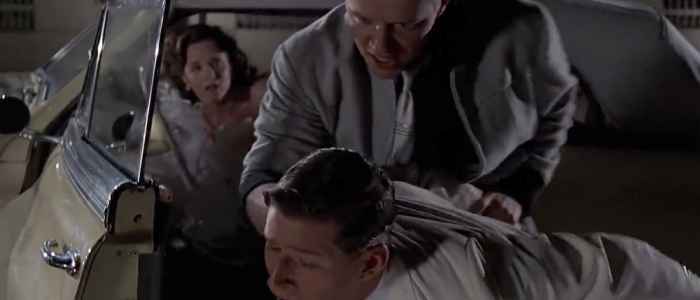
Supporting Characters In Relation to the Hero
Supporting characters in Back to the Future contribute significantly to the construction of Marty as the hero. They play an essential role in Marty’s coming-of-age and impact his evolution and the way he builds his own identity. His journey into the past is a learning experience, a test he has to pass in order to reach maturity and become an independent being able to overcome any challenges. Doc and Biff represent different examples of what Marty could become and they both act as two distinctive models of masculinity with contrasting sets of values that Marty can choose to embrace or defy. Doc becomes the surrogate father in the face of George’s failure to hold a strong patriarchal position. He pretends to be Marty’s uncle back in 1955, always offers a solution to his problems and cares about him like a father. The idea of Doc being Marty’s symbolic father is further explored in Back to the Future 3 where the interest in biological fathers is replaced by a focus on Doc. Susan Jefford 4 states that at the end of the trilogy, we understand that Marty has learned the most important values in life from Doc and not from his father. He learns to value the interest of the community over the self when Doc decides to sacrifice himself and not open Marty’s letter telling him about his future death to avoid creating negative consequences in the future. He learns that anything can happen if you persevere and work hard, and that it is the individual who counts in the making of history, values best exemplified in Doc’s impressive work on the DeLorean and his own impact on history. He also literally taught Marty how to take control of time which propelled the teenager on his self-discovery journey and gave him more agency to act on his surroundings. As such Marty is given more power for much of the film and Doc represents a masculine model of sobriety and generosity for Marty.
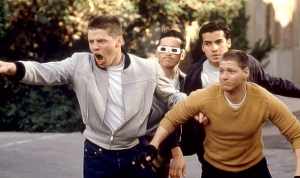
On the other hand, Biff represents excess and always needs to assert his control/masculinity. When we are first introduced to him, he is in the McFly house, bullying George and undermining his patriarchal control in the house, helping himself to food as if he owned the property and making his desire for Lorraine explicit. By imposing himself as the patriarch (before actually becoming Marty’s father in a Biff-controlled future in the next film) he enforces a brutal model of masculinity that Marty chooses to defy. Unlike Doc, Biff does not wish to help or care for Marty and presents himself as the obstacle to Marty’s vision of masculinity and fatherhood. Andrew Gordon 5 argues that is by castrating Biff and transferring his potency to George that Marty gives agency and strength to his father. He has passed his initial ritual and has become an active agent able to impact his surroundings. Supporting characters like Doc, George and Biff are therefore essential to Marty’s moral and masculine construction and embody the different choices that open up to the protagonist.
Biff and Doc are essential for Marty to move from the teenage world to the adult world. The supporting characters support the protagonist’s narrative of personal improvement and act as foils or backups to him through their typical and easily recognizable construction as friend and villain. As character types, they allude to specific genres that the audience can identify with and provide multiple tones to the film, and they also represent contrasting masculine constructs that Marty can chose to follow or reject. Therefore supporting characters in Back to the Future contribute to establishing a world for Marty to interact which, in that sense, follows the classic Hollywood model.
Works Cited
- Bordwell, David; Janet Staiger; Kristin Thompson, The Classical Hollywood Cinema: Film Style and Mode of Production to 1960. New York: Columbia University Press. 1985. ↩
- Bailey Steve, Hay James, cited in Stoate, Robin, Andrew Shail, Back to the Future, Palgrave Macmillan; 2010, p.48 ↩
- ‘“There’s something very familiar about all this”: generic play and performance in the Back to the Future trilogy (Robert Zemeckis, 1985, 1989, 1990)’ in Ni Fhlainn, Sorcha (ed.), The Worlds of Back to the Future. Jefferson: McFarland, 2010, 73-90. ↩
- Jeffords, Susan. Hard Bodies: Hollywood Masculinity in the Reagan Era. New Brunswick, N.J.: Rutgers UP, 1994. Print ↩
- Gordon, Andrew, Oedipus as Time Traveller, Science Fiction Studies
Vol. 14, No. 3, Science-Fiction Film (Nov., 1987), pp. 372-385 ↩
What do you think? Leave a comment.











And herein lies the usefulness of Hollywood stereotypes… It’s refreshing to read about such stock characters in a positive light. This is a great in-depth look at character construction through both visual and narrative storytelling – though I think we can just pause for a second and revel in how enjoyable BTTF is as a movie. It’s classic Hollywood popcorn entertainment, and your article is a reminder that it isn’t always a cash-grab. As much as terms like “stock characters” and “prototypes” are derided, it’s clear that they can be useful and, when dealing with a complex story involving time travel and two sets of characters, the stereotypes actually strengthen the story.
Now I just want to go re-watch the entire series again. SWEET.
A timeless classic with great supporting and lead characters.
I can remember seeing it for the first time around ten years ago and I was absolutely gob-smacked. It was funny, interesting, scientific, just stunning.
When I was little, my mom bought this movie on DVD for my dad. He turned it on one day and I brushed it off as “one of those weird old movies daddy likes”. Eventually, I came out, sat down, and watched it. And the rest was history.
For me, this is the total package of pure entertainment.
Great article. Back to the Future is one of my favorite trilogy, and that is because of the fantastic use of character development… and time travel of course.
Back to the Future is my favorite film of all time. I can’t see any faults in this film.
I was 13 years old in 1985 and, like most kids who watched this film, I wanted a really super cool time traveling delorean just like Doc and Marty.
Decades later, this film loses none of its charm, and actually gains respect.
My favorite thing about this movie is the relationship between Doc and Marty. Most of the time, when a kid or teen hang out with an older person in movies and TV, people think they’re more than friends.
I just love every scene and my favorite actor is Michael J. Fox.
Back To The Future was the first film that I did any written work for – way back in a year 9 English class.
An interesting analysis of a beloved classic!
one of the coolest movies ever produced for sure.
80s were presumably a great time for people with all these films coming out…
Excellent analysis. What’s not to love about this film?
“Back to the Future” has been my favorite movie for years, and I just don’t see that changing anytime soon.
I had the good fortunate to see all three ‘Back to the Future’ movies in cinema last year and it was such an experience to watch this timeless classic with people who enjoy this film as much as I do.
The script is genius!
Definitely and absolutely one of the greatest films of the 80s, and of all time. Every time you watch this film you’re hooked.
As a child, I used to watch this movie religiously. I loved the chemistry between Doc Brown and Marty McFly, I loved the all too familiar soundtrack and the ridiculous way in which George McFly laughs.
They captured perfectly that revolutionary atmosphere of the 80’s.
I love this movie. Great article. I love your attention to detail, especially your analysis on Biff and George’s fight towards the end of the film. Well done!
Awesome article, very interesting! Great Job!
This article covered an often overlooked topic: supporting characters. Also, I agree with Hitchcock about the villan piece. Even better when the antagonist is a villaness. Hard to believe it has been thirty years.
Not only an interesting analysis of the movie but I think your work on Doc Brown is particularly interesting, especially his connection to gothic/dark tropes
This movie has become such a nostalgic and feel-good film for me.
Such an amazing, funny Sci-Fi from the 1980’s.
An interesting look at the way the characters around Marty influence his growth. I think it’s sometimes easy to see Marty as a kind of Ferris Bueller type that triumphs against all adversity and looks cool while doing it–the best kind of hero– but he really would be lost without the supporting cast. I’d be interested to see how you think the two sequels’ use of parallel scenes intensifies what you see as overt cues to the audience relating to traditional film conventions and character types.
This movie has withstood the test of time because it can certainly be enjoyed 30 years later.
Supporting characters are too often overlooked. In some cases, they can provide critical insight into the mind and world of the main character. In other cases, the supporting character is absolutely crucial in developing a main character, sometimes to the point of being the only reason we are able to care for the star. In any case, this article provides a very well-constructed insight into a subject that is too often left underrated and overlooked. Thanks for this!
I wonder if the writer of “Back To The Future” had went into this much depth in writing these characters.
You did a good job at pointing out such specialties.
Hi I like back to the future
Doc Brown is also (underratedly) an exemplar of self-sacrifice. He sacrifices his whole life to make his dream invention and eventually succeeds. It costs him his fortune and home but he does so.